|
“Transylvania – Today” a blood-red opening caption informs us. This claim is then visually called into question when a bright yellow car of the sort you used to start by winding a crank handle rolls to a halt on a woodland road, and a man with the look and the dress sense of a Victorian professor (John Karlsen) steps out and walks drunkenly up an adjacent hill. On arriving at the ramshackle wooden entrance of a stone-walled building that sinks into the hillside, he stumbles inside and makes his way down a tunnel to a furnished cave dwelling in which he appears to reside. He then settles down on his bed and opens large, hand-bound autobiography written by his identically named ancestor, Count Gustav Von Helsing. And no, in this case ‘Von’ is not a typo.
As the voice in Von Helsing’s head lets us know what he is reading, we are transported back to a summer evening in 1865, when a funeral inside a village church is interrupted by the arrival of a young boy bearing the news that his brother has been taken by an as-yet unspecified woman. The priest and the congregation clearly know to whom the boy is referring, and one of the parishioners asks if he knows where this woman is. “If I tell you,” the boy asks nervously, “will you kill her?” “Yes,” the man replies reassuringly, “I’ll kill her.” Armed with the knowledge of her location and egged on by the bombastic priest, the parishioners grab torches and candles and head towards the cave in which this woman is hiding. When they reach it, the priest holds up a crucifix and commands that this creature of darkness come forth. What suddenly and aggressively emerges is a misshapen and haggard old witch named Vardella (played by male American dancer Jay 'Flash' Riley in heavy makeup), whose uses her considerable strength and claw-like fingers to attack the mob of villagers until they are able to collectively restrain her. They then carry her to the nearby lake, tie her to a ducking stool, drive a red-hot spike through her back, and douse her in the presumably purifying waters. With that, the professor closes his book and lights up a cigar to finish off his evening.
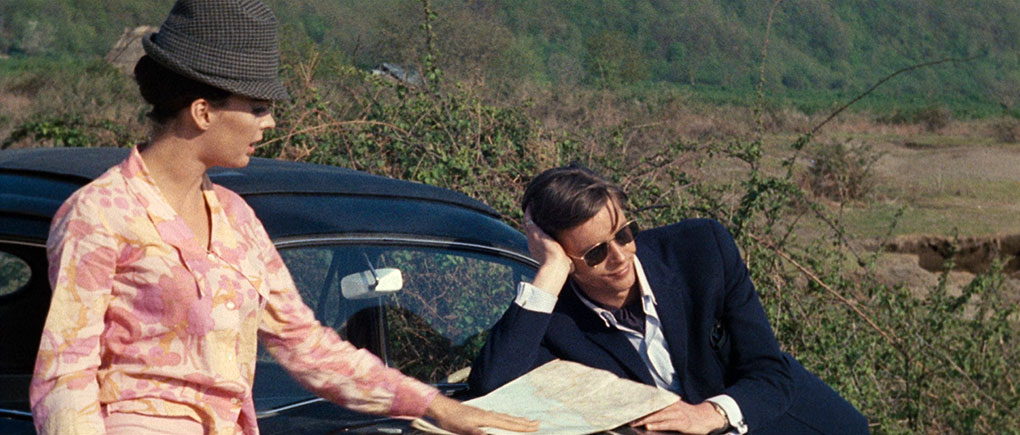
We’re then introduced to a more recognisably modern day Romania, as a Volkswagen Beetle belts along a dusty road in bright daylight and comes to halt. The occupants of the vehicle then emerge and are revealed to be newly married middle-class English couple Veronica (Barbara Steele) and Philip (Ian Ogolvy). For reasons best known only to themselves, they have come to picturesque but communist controlled Romania for their honeymoon and now are in the middle of nowhere and desperate to find somewhere to bed down for the night. Fortunately for them, a policeman (played by co-screenwriter Charles B. Griffith) just happens to be cycling down this otherwise completely deserted road, and he even speaks a little English. He directs them to the Hotel Maskva in the nearby village of Vaubrac, which they soon discover is run by a salacious and heavy-drinking slob with the unfortunate but appropriate name of Ladislav Groper (Mel Welles, also one of the screenwriters). Whilst sampling the hotel’s unpleasant take on tea, the newlyweds are approached by none other than the cave-dwelling, modern-day Count Gustav Von Helsing, who claims that his family were the ones who destroyed all of the Transylvanian vampires, the Draculas included. He tells them the story of Vardella and claims that the attempt to exorcise her, shown in the opening flashback, was effectively fumbled, allowing the old witch to put a curse on the village, its inhabitants, and their descendants. He wants to show them his library of books on demonic law, apparently the only ones left in Transylvania since the government outlawed black magic, but Veronica tells him that they’re both really tired from their journey and suggests that he bring the books round to the hotel tomorrow at noon. That she and Philip plan to leave first thing the morning is something she tactfully elects to keep to herself.
After being shown to their run-down room, Veronica and Philip get down to doing what honeymooning couples the world over do, only to realise that the sleazy Groper is watching them through the window. A furious Philip runs outside and beats Groper so badly that I was initially convinced that he’d killed him, ramming his head so firmly against the outside wall that it leaves the sort of bloodstains that suggest a fractured skull. Somehow Groper survives this assault and staggers to his feet, then responds by sabotaging Philip’s car. When the vehicle fails to start the following morning, Philip soon discovers that the distributor cap is missing and storms inside to forcibly retrieve it from the overhung Groper. The couple thus depart, but a short while later Philip realises that there was more to Groper’s vehicular sabotage than he originally surmised and he completely loses control of the steering and the brakes. After violently swerving, he narrowly misses an oncoming lorry and the car plunges into the very same lake in which Vardella was shown being drowned in the opening flashback. The lorry driver (Tony Antonelli) rushes to help, and while a shaken and exhausted Philip makes it to shore, there’s no sign of Veronica, so the driver gamely dives into the water in an vain attempt to save her. Minutes later, he rolls up at the Hotel Maskva to call in couple of owed favours, convinced that the police will blame him for the accident and owed a favour by Groper. Needing time to arrange a false alibi for himself, he presses Groper into helping him carry the unconscious Philip and the canvas-wrapped body of the dead Veronica into the hotel kitchen. The driver departs, and when Philip regains consciousness he is pointed to the body of Veronica by the once again drunken Groper. On discovering that the canvas-wrapped body is not that of his wife but that of a facially misshaped old woman, Philip loses his rag and angrily demands answers. So loud is his yelling that it attracts the attention of Count Von Helsing, who instantly recognises the dead woman as Vardella and instructs Philip to do exactly as he tells him if he wants to have a chance of saving his wife.

At the end of the commentary track on this very disc, lead actor Ian Ogilvy opines that the only reason The Revenge of the Blood Beast – aka She Beast – remains of interest today is because it was the first feature from director Michael Reeves. Elsewhere on this same disc, novelist and critic Kim Newman makes a solid case for why he thinks it’s rather a good film, only to then conclude by suggesting instead that it’s almost a good one. Frankly, I’m sympathetic to both viewpoints here, and the fact that it is the first feature by a young and talented director whose next two films were the rightly acclaimed The Sorcerers (1967) and Witchfinder General (1968) does indeed make it a film of considerable interest. That Reeves only made three features before he died of an accidental overdose at the criminally young age of 25 only deepens the tragedy of his untimely death, and we’re left to speculate about the films he should by rights have gone on to make. Instead we’re left with just three movies, the second of which is now held in high regard and gave Boris Karloff one of his best late career roles, while the third has achieved genre classic status and showcases Vincent Price at the top of his considerable game.
So what of this first feature. Ah, well, that’s a slightly different story, but before I start nitpicking, I do feel the need to cut Reeves some serious slack here. At a time when anyone with a mobile phone or a DSLR can make their own movie on a budget of snacks and coffee for the cast and small crew, it’s too easy to forget how damned difficult it once was to get even a low-budget film project off the ground. Back in the 1960s and 70s, any feature hoping for cinema distribution still had to be shot exclusively on acetate film using cameras that were expensive to hire, then edited on equipment that also incurred a serious rental fee. And film stock cost way more to buy than the SIM cards and SSD drives used by digital cameras today, and also had to be processed and printed by professional labs. Reeves was a serious enthusiast for film from a young age, and as a teenager travelled to the US and secured work as an assistant to director Don Seigel, whose films he deeply admired. He subsequently went to Rome and approached producer Paul Maslansky, who hired him to work as an assistant to director Warren Kiefer on the 1964 Castle of the Living Dead. Accounts of the exact nature of his contribution to that film tend to differ, but according to Maslansky, Reeves also directed some second-unit material, and the quality of his work caught the producer’s eye. Two years later, Reeves showed up in Rome again with a suitcase containing £17,000 of his own money (he was not exactly born into poverty, I should note) and asked if they could make a movie together. Maslansky agreed, and Revenge of the Blood Beast was born. At this point, Reeves was just 21 years of age.
Some of the odds stacked against Reeves are unsurprisingly visible in the final film. Despite having worked on several features and shot his own short films in his youth, here he was directing actors for the first time, some of whom were not professionals but members of the crew. He’d recruited his old friend, the RADA-trained Ian Ogilvy, to play the male lead, and producer Maslansky had procured the services of established film actress Barbara Steele for a single day, then worked her for so many hours that she didn’t speak to him again for years. Steele had already made a name for herself in Italian horror of the day, thanks in no small part to her memorable role as the avenging witch in Mario Bava’s Black Sunday (La maschera del demonio, 1960), whose setup Revenge of the Blood Beast partially apes. And for the most part, she and Ogilvy are fine as Veronica and Philip. As for the rest, well…
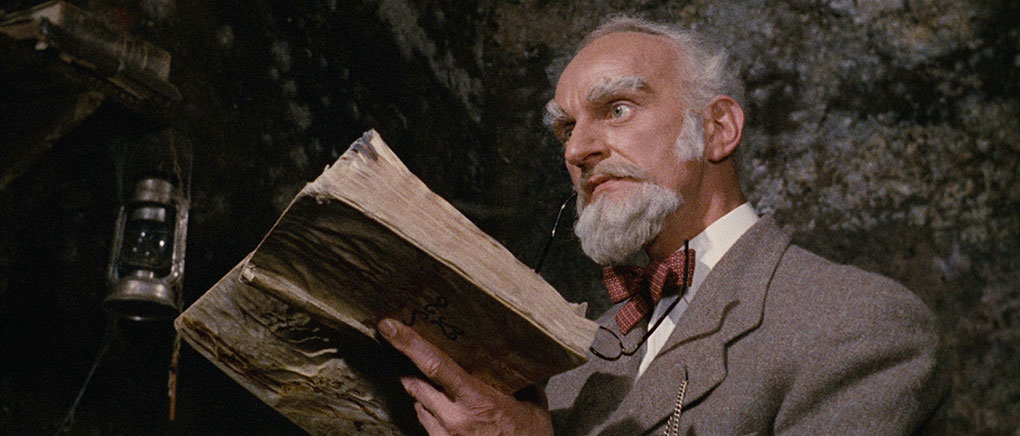
Working against the sort of naturalism that Reeves would get from his actors in his two subsequent films (both of which Ogilvy also co-starred in) is the fact that, in common with virtually all Italian productions of the day, all of the dialogue was redubbed in post, and you won’t need me to tell you this to work it out for yourself. Once again, Ogilvy and Steele come off best here – indeed, for the most part their dialogue feels as if it was recorded on location, at least on the English language track. That’s something that can’t be said for some of those in supporting roles. I’m torn when it comes to John Carlsen’s performance as Count Von Helsing, a likeable character who is actually rather fun, but he’s portrayed more as a very English Lord of the Manor than government-deposed member of the Romanian aristocracy, something Carlsen appears to have played up further in the dub. As for Mel Welles as Groper and Ennio Antonelli as his unnamed truck driver friend, on my first viewing I found myself intermittently wincing at their performances, but rewatching the film with a more sympathetic eye and ear, I found myself rather warming to them both, despite the fact the Groper is an appalling sleazebag of the lowest order. Indeed, in an uncomfortable scene that feels inserted primarily to pad the running time and spice up the violence with a bit of sexual assault, he’s visited one night by his attractive niece (Lucrecia Love) seeking shelter after hearing strange noises outside, and responds by inviting her in and attempting to rape her.
But the film’s most egregious sequence occurs late in the proceedings, and is so woefully misjudged and tonally inappropriate that I was genuinely relieved to discover that it was not directed by Reeves at all, but by the film’s second unit under the direction of either Mel Welles or Charles B. Griffith, depending on who you ask. Whoever it was, I hope they were dished out the appropriate number of corrective slaps. Up to this point, the film has played as a serious horror work, albeit one with a line in blackly comic moments, a sprinkling of which really do hit the mark. Then, as Philip and Von Helsing steal a police car and the cops give chase in Von Helsing’s ancient jalopy, it turns into a silent era slapstick comedy. I’m not exaggerating. The three cops are bumbling buffoons, and as the chase kicks off, some idiot decided to undercrank the camera and speed up the action to give it the look and feel of a Keystone Cops comedy, a perception enhanced by the addition of ha-ha music and comic carton boings on the inevitable pratfalls (and as director, Reeves has to take some of the blame for these post-production tics). Making matters worse is the decision to have the same single motorbike rider belt through almost every shot of the speeding cars from a variety of directions, destroying any semblance of reality and tipping the film into the realms of pure farce. What really makes this sequence so harmful is its positioning so close to the climactic scene, effectively poisoning the horror well and making it tough to re-adjust for the scene that follows, which we are supposed to take seriously and emotionally respond to. Apparently, Reeves was horrified when he saw the footage, but with their budget so limited, a shooting schedule too tight to allow for reshoots and a film that might otherwise be considered too short for theatrical distribution, the reluctant decision was made to keep the bloody thing in.
So is it all bad? Not by a long shot. I’m in agreement with Kim Newman here, whose suggestion that Revenge of the Blood Beast is almost a good film feels about right, and intermittently it’s better than that apt description might suggest. As I noted above, the story of a community cursed by a witch who was caught and executed by frightened local people for witchcraft was not new at this point, but it’s a solid foundation for a horror tale nonetheless (for notable precedents, see also John Moxey’s gorgeously atmospheric The City of the Dead, which was released the same year as the aforementioned Black Sunday). And while the notion of innocent westerners coming a dangerous cropper in strange foreign lands may have first been popularised by Bram Stoker back in 1897, the template is effectively set here for countless horror movies to come that are based around a similar premise, including the likes of Cannibal Holocaust (1980), Hostel (2005), The Descent (2005), The Ruins (2008) and Midsommar (2019). The dialogue may not exactly sparkle at times, but it does have its moments, such as when Groper serves a drink to Von Helsing with the mocking line, “Here you are, your ex-lordship,” one of several sly references to Romania’s then communist regime. This satirical undercurrent peaks in what has become the film’s most frequently referenced and visually amusing gag, when the revived Vardella violently murders her first victim with a sickle, which when tossed to the floor afterwards lands with perfect precision over the handle of a hammer.
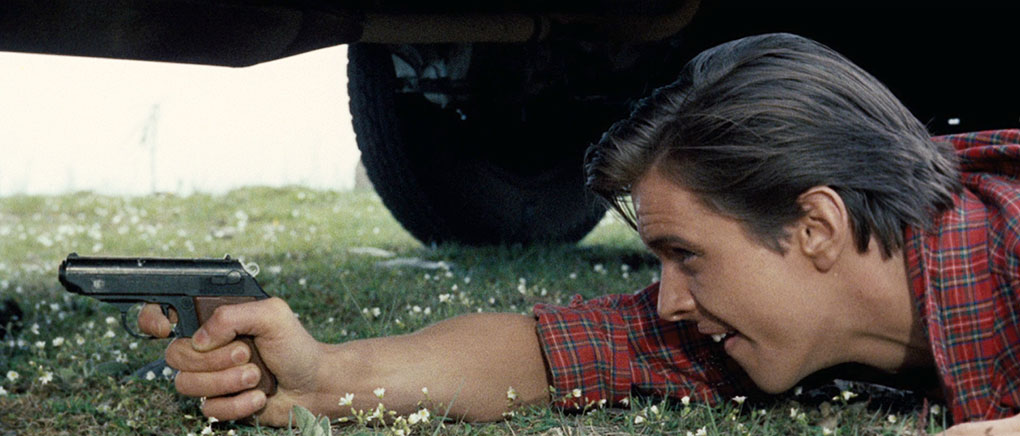
Vardella’s old hag makeup may not be as horrifying as it may once have seemed, but is no worse than its equivalent in Hammer films of the day, and there is one convincingly grisly effect that prompted me to mouth a silent “yikes!” in which a maggot crawls out of Vardella’s bloodied eyeball. The attempted rape aside, there’s also some rather pleasing nastiness here that foreshadows the more brutal scenes in Reeves’ most celebrated film, in the huge spike driven through Vardella with a hammer in the flashback scene, in the fury of the sickle murder, and in the excessively violent beating that Philip inflicts on Groper. Every bit as ruthless, at least by implication, is the sequence in which Groper reacts instinctively and knocks Philip cold, and instead of trying to revive him drags him into the road, where he leaves him to be run over by an approaching lorry. There are also some nicely judged character moments peppered throughout, from Groper’s drunkenly theatrical finger-twirling response to the confused Philip’s urgent questions to a nicely performed ‘will he/won’t he?’ moment when a gun-toting Philip takes aim at the approaching policemen, only to realise that, even with all that is potentially at stake, he just does not have it in him to take someone’s life.
All of which rotates us back to Ian Ogilvy’s comment that Revenge of the Blood Beast is only really of interest now because it was the debut feature of Michael Reeves, which as I intimated above is not the damning criticism that it might seem. For cineastes and genre fans alike, it’s always fascinating to go back to the early works of filmmakers of later note to search of early signs of the style that would go on to define their finest films, and that’s certainly the case with Reeves and Revenge of the Blood Beast. Despite his young age and relative inexperience, there’s a confidence to his direction evident in his savvy camera placement and the continuity of his visual storytelling, with subtly executed dolly moves purposefully employed and handheld POV shots capturing the frenzy of intense conflict. Providing able assistance are cinematographer Gioacchino Gengarelli and editor Nira Omri, both of whom deliver on their respective crafts, though I have a suspicion that day-for-night lighting and filtering was not really Gengarelli’s forte.
Despite being built around a by-then familiar premise and trading on elements that may now feel a little hackneyed, Revenge of the Blood Beast still has the makings of the solid little horror tale that it intermittently comes close to being. Despite uncertain moments, Ogilvy gives us a taste of what he would go on to deliver in Reeves’ subsequent two movies, and although confined by her schedule to only a few scenes, Barbara Steele is as effortlessly bewitching as ever. The film itself may get off to a hesitant start, but following the accident that transforms Veronica into Vardella, things do pick up and the story develops just enough intrigue and urgency to hold the interest, all of which is then almost sabotaged by that bloody car chase. Which is a real shame, because until this point the more verbally based comic moments are sometimes rather enjoyable in their small stabs at political satire and their acknowledgement and usurping of genre expectations and cliché. You’d have to hear how a drunken Groper delivers the line, “Privacy breeds conspiracy!” to understand why it put such a smile on my face, and when a surly Veronica returns to their hotel room after a clearly unhappy attempt to wash, we get the following exchange between her and Philip:
| Philip: |
What’s the matter with you? Bath taps running blood or something? |
|
| Veronica: |
I almost wish they were. All I got was a two-minute shower and an avalanche of rust. |
|
| Philip: |
Long live social democracy. |
|
In the end, whatever your view of the film, it’s worth remembering that were it not for Revenge of the Blood Beast we may well never have had The Sorcerers or Witchfinder General, which would have been a crime against British horror cinema. For that alone this film deserves our respect, and for all its often circumstance-imposed faults, it’s an often enjoyable and intermittently assured first step for a young budding director whose talent would soon be established beyond question. But is it a good film? Well, maybe not quite. But almost.
As far as I’m aware, this is the second time Revenge of the Blood Beast has been released on Blu-ray by Raro Video, and it would seem that this new edition from Raro UK via Radiance Films represents an upgrade from one released in 2017, which from what I have read was lighter on special features and sporting a less than sparkling transfer. Happily, the 1080p transfer on this new disc, which was sourced from an HD restoration from the original camera negative, is in impressive shape. Framed in the film’s original aspect ratio of 2.35:1, the image here is consistently sharp, with nicely balanced contrast, solid black levels, robust shadow detail, and attractively rendered, largely naturalistic and occasionally vibrant colour – Von Helsing’s bright yellow car really pops from the screen. The picture is clean of dust and pronounced signs of wear, although there is some very jitter during some sequences. A fine film grain is visible throughout.
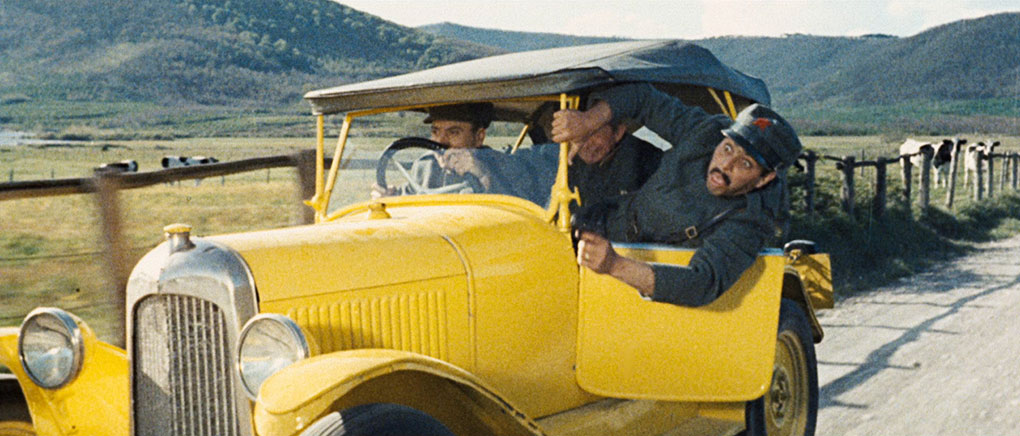
In common with most films shot in Italy in the late 1960s, Revenge of the Blood Beast was filmed without synchronised sound and the dialogue and effects were post-dubbed. This allowed the creation of an Italian language track for domestic audiences and an English language track for the international market, both of which have been included on this Blu-ray. With the leads dubbing their own voices on the English language track and delivering lines that were originally written in English under the direction of a British director, for me the English language track was the way to go, but it’s great to have the choice, not least to see how lines are subtly altered on the Italian track to fit. Both tracks are presented here in Linear PCM 2.0 mono, but when it comes to the clarity and fidelity of the dialogue, the English language track definitely has the edge, and as I noted above, in the case of Ogilvy and Steele, it often sounds as if the dialogue was recorded live. There are some inevitable tonal range restrictions on both tracks, and some minor traces of wear in the shape of a faint background hiss and the occasional small pop, but otherwise both are fine.
Optional English subtitles are provided for the Italian track and optional English subtitles for the hearing impaired are available for the English language track. The method for selecting these when you choose to play the film on the main menu is elegantly simple.
Audio commentary with producer Paul Maslansky and actors Ian Ogilvy and Barbara Steele
Recorded in 2007, I’m guessing for a previous North American DVD release, this commentary track is a seriously valuable grab for this new Blu-ray. Moderated by David Gregory, it initially features lead actor Ian Ogilvy and producer Paul Maslansky, who are joined 14 minutes in by Barabara Steele. Pleasingly, all three are happy to talk about the film and their work on it, though are not always complimentary about the result. Ogilvy in particular is surprisingly self-deprecating, scorning his skinny body (which Steele then praises) and claiming that he now looks back at his performance in horror and wonders what he was doing. The background information on the production provided by Maslansky and Ogilvy is of particular interest, with Ogilvy recalling how first met Reeves through a school friend and began shooting amateur films with him in their teenage years, and Maslansky revealing that he first met Reeves when the then 18-year-old hopeful turned up at the shoot of Jack Cardiff’s 1964 The Long Ships and announced that he’d like to become an assistant. All three praise Reeves’ energy and enthusiasm, as well as that of the dedicated Italian crew, and there’s a fun story about how Jay ‘Flash’ Riley used to prank passing motorists in full Vardella makeup. Maslansky confirms that the film was shot in 18 days on a budget of £17,000, and recalls that they only had Steele for a single day, and that after they worked her for 18 hours straight (22 according to Steele) she refused speak to him for over ten years. Steele waxes lyrical over her love of Italy with such passion that it made me want to fly there immediately, though it’s she who delivers the sharpest blow to the film when she asks in disbelief, “Good lord, how did this movie get made, who financed this script?” This is just a small sample from a quite wonderful commentary.
Interview with actor Ian Ogilvy (12:57)
Given that many years have passed since the recording of the above-detailed commentary, it’s hardly surprising that this more recently shot interview with the immensely likeable Ian Ogilvy covers some of the same ground. This includes how he first met and made short films with Reeves, how he reunited with him later when Reeves sought him out to star in what proved to be the debut feature for both men, how the project got off the ground, and why the pretence of shooting a documentary saved the production money. He notes that Reeves liked and trusted actors and that he had his hand in all aspects of the production, and remains convinced (as we all are) that Reeves would have gone on to be a big name in the industry had his life not been cut tragically short at such a young age. He recalls that it was a fun film to make but is of the opinion that it doesn’t stand up at all and claims to now be slightly embarrassed by it, but acknowledges that it has a following amongst fans of Reeves’ later films.
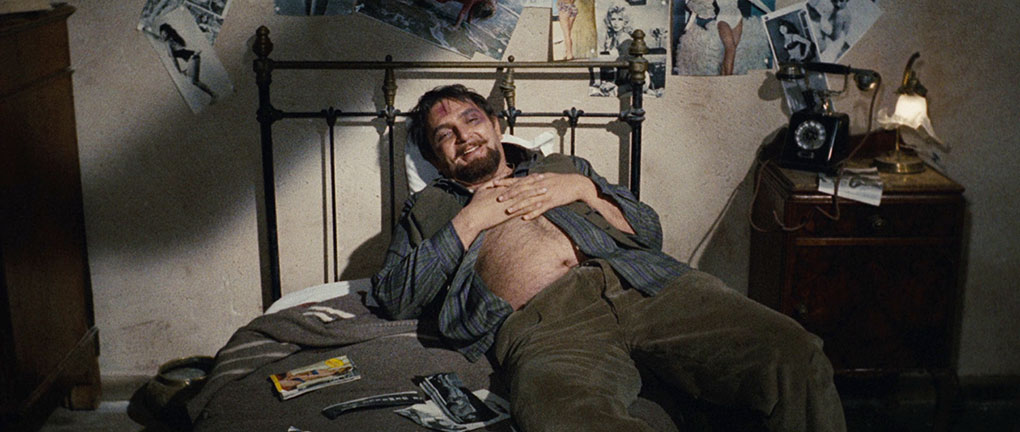
Interview with critic Kim Newman (19:32)
Novelist, critic, and hugely knowledgeable horror expert Newman kicks off with a famous anecdote about an argument between Michael Reeves and Vincent Price on the set of Witchfinder General, which leads into why he believes that Revenge of the Blood Beast is “a pretty good film,” a claim he makes a small but significant adjustment to before signing off. His warming to the film’s mix of horror and comedy flies in the face of the disdain for it expressed by Ogilvy, and he amusingly describes the film’s fantastical version of Eastern Europe of the day as Carry On Communism. He highlights the fact that was the first film to toy with the idea that Van (or in this case, Von) Helsing was not a lone figure but part of a dynasty of monster fighters, though appears to slightly disremember the film’s penultimate shot (spoilers ahead – skip to the following extra to avoid), when he claims that this is one of several films that ends with Barbara Steele looking into the camera and smiling – I know exactly where he’s coming from on this, but in this case there’s no look at the camera and only the smallest (albeit effective) trace of a smile.
Audio interview with Barbara Steele (28:30)
Actually titled A Bloody Journey to Italy, I gather that this audio interview with Barbara Steele, which is illustrated with photographs, posters and film extracts, has been carried over from the 2017 Raro Blu-ray and is another welcome inclusion here. Steele looks back at how she went from studying art in London to acting contracts with Rank and then 20th Century Fox, who put her in a movie with Elvis Presley because she was good with horses (the 1960 Flaming Star), where she had a bust-up with director Don Seigel and promptly walked from the movie and a potential career in Hollywood. She talks about travelling to Italy and meeting director Mario Bava, for whom she made Black Sunday, which lead to steady work in a string of Italian films, which for her proved secondary to her love affair with the country and its people. She praises Bava as private, shy, elegant and lovely to work with, recalls how the burning at the stake scene nearly saw the fire get out of control, wonders what it is about her personality that resulted in her being typecast in horror, and admits that she would love to have done more comedy films. Having worked with some notable directors – including Federico Fellini (for whom she did 8½, 1963), Ricardo Freda (The Ghost/Lo spettro, 1963), Luciano Salce (The Hours of Love/Le ore dell'amore, 1963) and Mario Monicelli (L'armata Brancaleone, 1966) – she has plenty of interesting stories about the films and the filmmakers. One film that doesn’t get a mention is Revenge of the Blood Beast, which does make the many extracts from it that the interview is intermittently paused for feel a little like superfluous padding.
If you come to Revenge of the Blood Beast expecting a work of the quality of The Sorcerers or especially Witchfinder General, you’ll likely be in for a serious disappointment, and I’ll admit that I wasn’t sure how to react to the film the first time I saw it. A couple of viewings later it still has its issues, not least that bloody car chase, and the passing of time has not been that kind to elements that may once have had a twang of real originality. But cut it the sort of slack that a low-budget debut feature by a young and relatively inexperienced director deserves, and the film has more to offer than judgemental first impressions might initially suggest. It’s certainly great to see it made available again on Blu-ray with such a solid transfer and special features of such quality, and with The Sorcerers coming very soon to Blu-ray from 88 Films and Witchfinder General already available on Blu-ray and 4K UHD from the same label, this Raro Video disc will allow you to complete your HD Michael Reeves collection. For that, the better moments of the film, and the quality extras, it thus comes recommended.
|